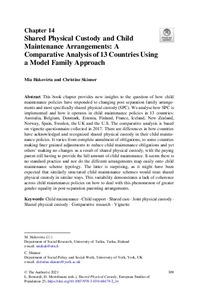Shared Physical Custody and Child Maintenance Arrangements: A Comparative Analysis of 13 Countries Using a Model Family Approach
Hakovirta Mia; Skinner Christine
https://urn.fi/URN:NBN:fi-fe2022012710911
Tiivistelmä
This book chapter provides new insights to the question of how child maintenance policies have responded to changing post separation family arrangements and most specifically shared physical custody (SPC). We analyse how SPC is implemented and how it operates in child maintenance policies in 13 countries: Australia, Belgium, Denmark, Estonia, Finland, France, Iceland, New Zealand, Norway, Spain, Sweden, the UK and the U.S. The comparative analysis is based on vignette questionnaire collected in 2017. There are differences in how countries have acknowledged and recognized shared physical custody in their child maintenance policies. It varies from complete annulment of obligations, to some countries making finer grained adjustments to reduce child maintenance obligations and yet others’ making no changes as a result of shared physical custody, with the paying parent still having to provide the full amount of child maintenance. It seems there is no standard practice and nor do the different arrangements map easily onto child maintenance scheme typology. The latter is surprising, as it might have been expected that similarly structured child maintenance schemes would treat shared physical custody in similar ways. This variability demonstrates a lack of coherence across child maintenance policies on how to deal with this phenomenon of greater gender equality in post-separation parenting arrangements.
Kokoelmat
- Rinnakkaistallenteet [19207]
